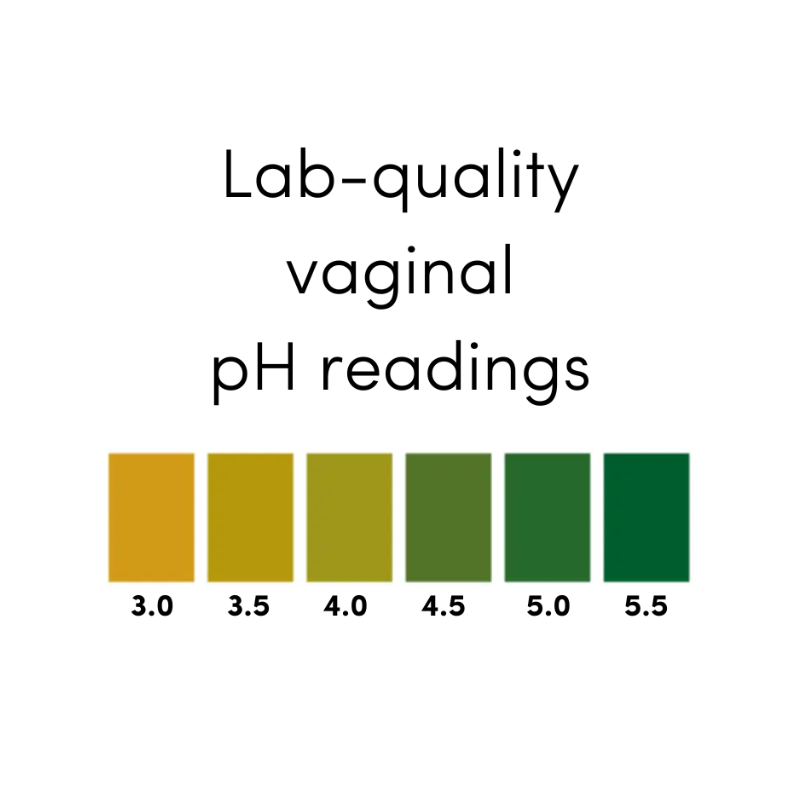Testing your vaginal pH at home is quick, easy and reasonably cheap, and can provide some very valuable information: an indication of what microbes are living in your vagina.
When you start testing your vaginal pH, test regularly and record your results.
Remember if you’ve used a vaginal treatment recently, your results may be a reading of your treatment, not your true vaginal fluids. Record the time of your last treatment as well.
What you need to test vaginal pH
- Vaginal pH strips in at least 0.5 increments or less
If you’re still getting regular periods, choose strips with at least 4.0-5.0 on the scale, but if you’re menopausal, your pH may be over this and be perfectly normal - Enough vaginal fluid to cover the coloured area of the strips.
- Reasonable lighting and vision to check the colours
How to do the vaginal pH test
You need the coloured part of the pH strip to be covered completely in vaginal fluids for an accurate result.
- Holding on tight, push the pH strip inside your vagina (but don’t let go of it!), smoosh it around a bit so it gets covered, then pull it back out.
- You can also use a clean, dry finger to scoop some out vaginal fluids and smear liberally across the strip’s coloured section.
- Without letting the fluids dry, check the colour change with the colour chart.
- If you’re really dry, it can be difficult to get an accurate pH reading – it does require vaginal fluids.

Understanding your vaginal pH test results
To read the vaginal pH test results, you need to match the colour of your pH strip to the coloured squares on the box/packet of strips.
Vaginal pH strip colours vary between manufacturers, so you must use the packet your strips came out of.
- Vaginal pH tends to sit at 3.8 – 4.5 premenopause1
- 4.5 is a respectable reading and within healthy range
- In menopause, vaginal pH is about 5.5 but can vary depending on which bacteria are present2–4
- BV pH tends to be over 4.51
- AV pH may vary between 3.8-4.5 or above5–7
- In AV, pH can be within normal ranges, because some AV bacteria are also lactic-acid producing bacteria despite being pathogens – the pH will depend on which bacteria are present and dominant
- Cytolytic vaginosis (CV) pH is 3.8-4.5, usually sitting around 4.0 with an abundance of lactobacilli producing plenty of lactic acid, dropping the pH
- Yeast do not change vaginal pH and are acid-tolerant8
- You can have a pH in the normal range and a flora imbalance at the same time
- It is rare to have a pH of less than 3 or past 8 or 9 – but not impossible, though if you’re getting these readings, try another brand of vaginal pH strips or see a doctor to be tested in a clinical setting as it may indicate an issue worth investigating
- If you have a vaginal microbiome report that doesn’t match your pH readings, check the strips – e.g. if you have a very healthy-looking lactobacilli-abundant vaginal microbiome, but your pH keeps reading 5.0, try different strips, as quality can vary significantly – we recommend Hydrion vaginal pH strips as they are lab-quality and very accurate.
- If your vaginal pH is over 4.5, don’t panic!
- If you have symptoms, see your doctor for a test or get a comprehensive vaginal microbiome test)
- If you don’t have any symptoms, you may be one of the lucky ones who have normal flora that has a naturally higher pH (but, if you’re concerned, get a test and check)
References
- 1.Lin YP, Chen WC, Cheng CM, Shen CJ. Vaginal pH Value for Clinical Diagnosis and Treatment of Common Vaginitis. Diagnostics. Published online October 27, 2021:1996. doi:10.3390/diagnostics11111996
- 2.Caillouette JC, Sharp CF Jr, Zimmerman GJ, Roy S. Vaginal pH as a marker for bacterial pathogens and menopausal status. American Journal of Obstetrics and Gynecology. Published online June 1997:1270-1277. doi:10.1016/s0002-9378(97)70345-4
- 3.Das A, Panda S, Singh A, Pala S. Vaginal pH: A marker for menopause. J Mid-life Health. Published online 2014:34. doi:10.4103/0976-7800.127789
- 4.Tucker KM, Godha K, Mirkin S, Archer DF. Vaginal pH: a simple assessment highly correlated with vaginal morphology and symptoms in postmenopausal women. Menopause. Published online July 2018:762-766. doi:10.1097/gme.0000000000001081
- 5.Jahic M. Aerobic Vaginitis Caused by Enterococcus Faecalis – Clinical Features and Treatment. Mater Sociomed. Published online 2022:291. doi:10.5455/msm.2022.34.291-295
- 6.Donders GGG, Bellen G, Grinceviciene S, Ruban K, Vieira-Baptista P. Aerobic vaginitis: no longer a stranger. Research in Microbiology. Published online November 2017:845-858. doi:10.1016/j.resmic.2017.04.004
- 7.Kaambo E, Africa C, Chambuso R, Passmore JAS. Vaginal Microbiomes Associated With Aerobic Vaginitis and Bacterial Vaginosis. Front Public Health. Published online March 26, 2018. doi:10.3389/fpubh.2018.00078
- 8.Drake SM, Evans BA, Gerken A. Vaginal pH and microflora related to yeast infections and treatment. Sexually Transmitted Infections. Published online April 1, 1980:107-110. doi:10.1136/sti.56.2.107
The most comprehensive vaginal microbiome test you can take at home, brought to you by world-leading vaginal microbiome scientists at Juno Bio.
Unique, comprehensive BV, AV and 'mystery bad vag' treatment guide, one-of-a-kind system, with effective, innovative treatments.
Promote and support a protective vaginal microbiome with tailored probiotic species.






